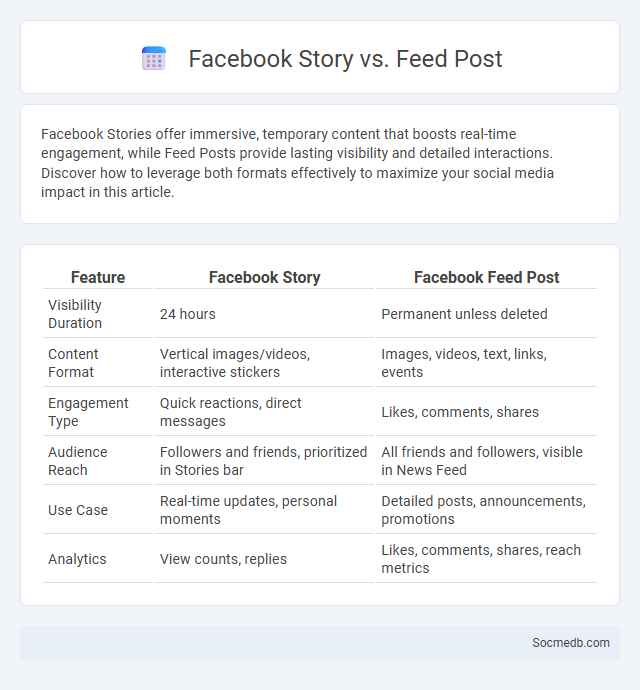
Photo illustration: Facebook Story vs Feed Post
Facebook Stories offer immersive, temporary content that boosts real-time engagement, while Feed Posts provide lasting visibility and detailed interactions. Discover how to leverage both formats effectively to maximize your social media impact in this article.
Table of Comparison
| Feature | Facebook Story | Facebook Feed Post |
|---|---|---|
| Visibility Duration | 24 hours | Permanent unless deleted |
| Content Format | Vertical images/videos, interactive stickers | Images, videos, text, links, events |
| Engagement Type | Quick reactions, direct messages | Likes, comments, shares |
| Audience Reach | Followers and friends, prioritized in Stories bar | All friends and followers, visible in News Feed |
| Use Case | Real-time updates, personal moments | Detailed posts, announcements, promotions |
| Analytics | View counts, replies | Likes, comments, shares, reach metrics |
Understanding Facebook Story, Feed Post, and Story
Facebook Story allows you to share ephemeral content that disappears after 24 hours, creating a sense of urgency and real-time engagement. Your Feed Post appears permanently on your timeline, enabling longer-form content with options for comments, likes, and shares to foster ongoing interaction. Understanding the distinct purposes and formats of Facebook Story, Feed Post, and Story helps optimize your social media strategy for maximum reach and audience engagement.
Key Features of Facebook Story
Facebook Story offers immersive, full-screen photos and videos that last for 24 hours, enabling real-time sharing with your friends and followers. Your Story can include interactive elements such as polls, music, stickers, and location tags to boost engagement and personalization. The feature supports seamless integration with Messenger for direct replies and allows privacy settings to control who sees your content.
Core Elements of Facebook Feed Post
Facebook feed posts center around core elements such as the profile picture, user name, timestamp, and post content, which can include text, images, videos, or links. Engagement features like reactions, comments, and shares are prominently displayed to encourage interaction. The algorithm prioritizes posts based on relevance, user preferences, and engagement history to optimize visibility within users' feeds.
Differences Between Story and Feed Post
Story posts on social media are temporary content that disappears after 24 hours and are designed for quick, engaging updates often enhanced with stickers, polls, or interactive elements. Feed posts, by contrast, remain permanently on a user's profile, providing a curated gallery of images, videos, or text intended for long-term visibility and engagement. Stories prioritize real-time interaction and immediacy, while feed posts emphasize lasting presence and structured content organization.
Ideal Content for Facebook Story
Ideal content for a Facebook Story combines engaging visuals with authentic storytelling to capture Your audience's attention quickly. Short, vibrant videos or images highlighting behind-the-scenes moments, limited-time offers, or interactive polls boost engagement and encourage instant interaction. Incorporating clear calls-to-action and branded elements ensures Your Story stands out and drives meaningful responses.
Best Uses for Facebook Feed Posts
Facebook feed posts excel at driving engagement through visually appealing images, concise text, and strategic use of hashtags. You can leverage these posts to showcase promotions, share customer testimonials, or announce events, capitalizing on Facebook's vast user base and targeting options. Optimizing post timing and interaction boosts visibility, increasing brand awareness and user interaction.
Audience Engagement: Story vs Feed Post
Story posts on social media deliver immediate, interactive experiences that capture your audience's attention with ephemeral content, boosting engagement through polls, questions, and swipe actions. Feed posts, by contrast, provide lasting visibility and appeal through carefully crafted visuals and captions that drive conversations and encourage shares. Balancing story and feed posts maximizes audience interaction, enhancing your overall social media presence.
Lifespan and Visibility Comparison
Social media platforms vary significantly in lifespan and visibility, with content on sites like Twitter having short-lived visibility of minutes to hours, while posts on Facebook and Instagram can remain relevant for days or even weeks. Your engagement strategy should consider the fleeting nature of stories and tweets versus the longer-lasting impact of evergreen posts on Pinterest and LinkedIn. Understanding these differences helps maximize your content's reach and ensures your message stays visible to the right audience at the optimal time.
Analytics: Measuring Story vs Feed Post Performance
Measuring story vs feed post performance on social media requires analyzing key metrics such as engagement rates, reach, impressions, and click-through rates for each content type. Stories often generate higher immediacy and interaction through features like polls and swipe-ups, while feed posts typically offer longer lifespan and broader visibility. Understanding these distinctions helps you optimize your content strategy and maximize your audience engagement effectively.
Choosing the Right Format for Your Facebook Strategy
Selecting the optimal format for your Facebook strategy significantly enhances content engagement and audience reach. Video posts boost interaction rates by up to 135%, while carousel ads showcase multiple products, increasing click-through rates by 10%. Tailoring your content format to align with your target demographic behaviors on Facebook maximizes your campaign's effectiveness and ROI.
 socmedb.com
socmedb.com